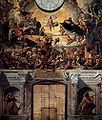- Dirck Barendsz
-
Portrait of Joost Buyck (1505-1588) by Jacobus Houbraken, after a copy of a painting by Dirck Barentsz (since lost).

Dirck Barendsz or Theodor Barendszoon (1534–1592) was a Dutch Renaissance painter from Amsterdam who traveled to Italy in his youth to learn from the Italian masters, most notably Titian.
Contents
Biography
He was trained by his father, a painter known as deaf Barent,[1] and in 1555, at the age of twenty-one, Barendsz travelled to Italy. During his seven-year stay there, Karel van Mander tells us that he was "nursed at the great Titian's bosem."[2][3]
He was a great friend of Philip Van Marnix, who he met in Rome, and Dominicus Lampsonius, with whom he corresponded in Latin.[1] He was a good musician and his most notable work, among various other pieces Van Mander describes that he painted in Amsterdam, was a Judith.[1] Among pieces worthy of mention in Leiden that Van Mander liked was a Venus that at the time he was writing in 1604 was in the possession of Sybrandt Buyck (son of the last Catholic mayor of Amsterdam, Joost Sijbrantsz Buyck). Van Mander further lists a Table and a Christmas piece in the possession of the Franciscans in Gouda, and a copy of a tronie by Titian, in the possession of Pieter Isaacsz (1569–1625), an Amsterdam painter and art dealer.
He died in Amsterdam.
Gallery
-
The Last Judgment, Benedictine Abbey, Fara in Sabina
References
- ^ a b c (Dutch) Dirck Barentsen biography in Karel van Mander's Schilderboeck, 1604, courtesy of the Digital library for Dutch literature
- ^ "Dirck Barentsen, die Schilder geboren wesende, noch daerenboven des grooten Titiaens boesem heeft ghenoten"
- ^ Marcel Roethlisberger, Review of Dirck Barendsz. 1534-1592 by J. Richard Judson and Jan Asselijn by Anne Charlotte Steland-Stief, The Art Bulletin, vol. 54 (Dec., 1972), pp. 553-555.
Further reading
- Rose, Hugh James (1857). A New General Biographical Dictionary, London: B. Fellowes et al.
Categories:- 1534 births
- 1592 deaths
- Early Netherlandish painters
- People from Amsterdam
- Netherlandish painter stubs
Wikimedia Foundation. 2010.



